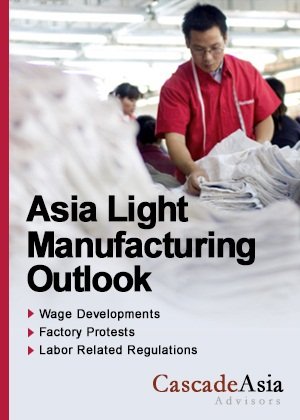Outlook on Light Manufacturing in China: April 2015
The below is a sample of Cascade Asia Advisor’s monthly report on light manufacturing across emerging Asia, available for purchase through the Asia Briefing bookstore. The report is a 4-5 page executive-ready assessment and outlook designed to help companies anticipate labor risks and dynamics across key manufacturing countries in Asia. Countries of coverage include Cambodia, China, Indonesia and Vietnam.
China
 Roughly 90% of migrant workers have returned to their work posts since the Chinese New Year, leaving some 20% of manufacturing enterprises in coastal provinces clamoring to recruit for vacant positions. Smaller suppliers are among the worst affected due to a serious mismatch between jobs offered and expectations of young job seekers, particularly as they give increasing consideration to workplace environment and personal development. Meanwhile, workers’ disputes over wages, benefits and social security will gradually return to the pre-holiday cadence.
Roughly 90% of migrant workers have returned to their work posts since the Chinese New Year, leaving some 20% of manufacturing enterprises in coastal provinces clamoring to recruit for vacant positions. Smaller suppliers are among the worst affected due to a serious mismatch between jobs offered and expectations of young job seekers, particularly as they give increasing consideration to workplace environment and personal development. Meanwhile, workers’ disputes over wages, benefits and social security will gradually return to the pre-holiday cadence.
Guangdong: Guangdong’s minimum wage will rise nearly 20 percent on average across the province starting from May 1. The adjustment is expected to have minimal immediate impact on factories’ financial status, as most already pay well above the minimum threshold. The new wage floor may have a more medium term ripple-effect on workers earning wages near the threshold rate.
Dongguan – The recently reformed Dongguan Housing Fund regulation forbids employees from withdrawing their housing fund money paid in cash after March 1. The policy has upset workers and triggered several protests demanding factories to pay off contributions made prior to March 1 (the part eligible to be withdrawn). Such demands are likely to grow as workers’ attention is more intensively focused on social security issues.
Fujian: The Quanzhou city government recently issued a notification stressing bottlenecks faced by local footwear manufacturers and the urgency of industrial upgrades through technology innovation and transformation. This is a sign both the city and provincial governments intend to maintain Quanzhou as one of China’s primary footwear production bases.
The policy outlines specific measures such as reinforcing bank loans, issuing automation subsidies, rewarding talent recruitment and expansion overseas, while also highlighting the industry’s increasing need of a skilled workforce.
Zhejiang: While the Machines Replace Labor initiative would presumably reduce the total number of entry-level manual jobs available, a recent survey suggests that nearly 80 percent of enterprises in Zhejiang are in growing demand of highly skilled employees to cope with more advanced equipment and streamlined production processes.
|
Cascade Asia Advisors is a boutique advisory firm focused on Southeast Asia. They help businesses anticipate risk and make better decisions using forward-looking, localized intelligence. For information about developments mentioned in this report, please contact them at info@cascadeasia.com. Asia Briefing Ltd. is a subsidiary of Dezan Shira & Associates. Dezan Shira is a specialist foreign direct investment practice, providing corporate establishment, business advisory, tax advisory and compliance, accounting, payroll, due diligence and financial review services to multinationals investing in China, Hong Kong, India, Vietnam, Singapore and the rest of ASEAN. For further information, please email china@dezshira.com or visit www.dezshira.com. Stay up to date with the latest business and investment trends in Asia by subscribing to our complimentary update service featuring news, commentary and regulatory insight. |
![]()
 Manufacturing Hubs Across Emerging Asia
Manufacturing Hubs Across Emerging Asia
In this issue of Asia Briefing Magazine, we explore several of the region’s most competitive and promising manufacturing locales including India, Indonesia, Malaysia, Singapore, Thailand and Vietnam. Exploring a wide variety of factors such as key industries, investment regulations, and labor, shipping, and operational costs, we delineate the cost competitiveness and ease of investment in each while highlighting Indonesia, Vietnam and India’s exceptional potential as the manufacturing leaders of the future.
 The Asia Sourcing Guide 2015
The Asia Sourcing Guide 2015
In this issue of Asia Briefing, we explain how and why the Asian sourcing market is changing, compare wage overheads, and look at where certain types of products are being manufactured and exported. We discuss the impact of ASEAN’s Free Trade Agreements with China and India, and highlight the options available for establishing a sourcing model in three locations: Vietnam, China, and India. Finally, we examines the differences in quality control in each of these markets.
 Adapting Your China WFOE to Service China’s Consumers
Adapting Your China WFOE to Service China’s Consumers
In this issue of China Briefing Magazine, we look at the challenges posed to manufacturers amidst China’s rising labor costs and stricter environmental regulations. Manufacturing WFOEs in China should adapt by expanding their business scope to include distribution and determine suitable supply chain solutions. In this regard, we will take a look at the opportunities in China’s domestic consumer market and forecast the sectors that are set to boom in the coming years.
- Previous Article Setting Up a Dental Clinic in China
- Next Article Les Nouvelles Tendances du Marché du Café en Chine




























